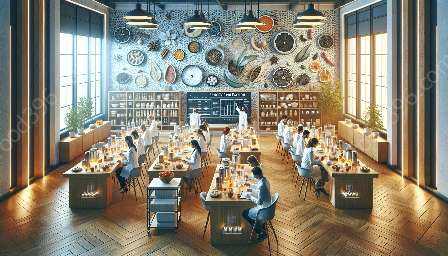Have you ever wondered why certain foods taste, smell, or feel a certain way? Or how our senses shape our perception of food? Welcome to the captivating realm of sensory science, where the exploration of our senses and their relationship to food and drink takes center stage. In this topic cluster, we will delve into the intricate world of sensory science, its connection to sensory evaluation, and its impact on the exciting field of culinology.
Understanding Sensory Science
Sensory science, also known as sensory analysis, is a multidisciplinary field that focuses on the study of human perception and the responses to stimuli. It encompasses the sensory evaluation of food, beverages, and other consumer products, as well as the sensory aspects of the culinary experience.
Sensory evaluation plays a pivotal role in sensory science, as it involves the systematic analysis of sensory attributes, such as taste, aroma, texture, appearance, and mouthfeel. Through sensory evaluation, researchers and professionals seek to understand how humans perceive and interpret sensory stimuli, leading to insights that can inform product development, quality control, and consumer satisfaction.
The Role of our Senses in Food Perception
Our senses—taste, smell, sight, touch, and even sound—play a crucial role in shaping our perception of food. The aroma of freshly baked bread, the delicate texture of a ripe peach, the vibrant colors of a salad, and the sizzle of a steak on the grill—all these sensory experiences contribute to our overall enjoyment and understanding of the culinary world.
Culinology, a fusion of culinary arts and food science, integrates sensory science into the creation and enhancement of food products. Culinologists utilize their understanding of sensory attributes to develop innovative flavors, textures, and experiences that appeal to the consumers' senses and preferences.
The Art and Science of Sensory Evaluation
Sensory evaluation, as a critical component of sensory science, involves various methods and techniques designed to assess and measure human perception. These methods may include descriptive analysis, discrimination testing, consumer testing, and affective testing, each offering valuable insights into the sensory properties of food and beverages.
The diverse sensory evaluation methods are utilized across the food industry, from developing new recipes and conducting market research to ensuring consistent quality and optimizing the sensory appeal of food and beverage products.
Exploring Sensory Science in Culinology
Culinology, at the intersection of culinary arts and food science, draws on sensory science principles to create delightful and flavorful culinary experiences. By understanding how sensory attributes influence consumer preferences, culinologists can innovate and refine food products, adapting to evolving consumer tastes and preferences while ensuring consistent sensory quality.
Moreover, sensory science plays a vital role in product development, as it provides an in-depth understanding of the sensory drivers of consumer acceptance and satisfaction. Through sensory evaluation techniques, culinologists can fine-tune the sensory profiles of food and beverage products, ensuring that they resonate with the desires and expectations of the target audience.
Embracing the Multifaceted World of Sensory Science
The multifaceted nature of sensory science extends beyond the food industry, encompassing fields such as psychology, neurobiology, and consumer behavior. The insights gleaned from sensory science research have practical applications in product development, marketing strategies, and even the design of sensory experiences in hospitality and culinary tourism.
Sensory science, sensory evaluation, and culinology converge to enhance our understanding of the intricate relationship between sensory perception and the culinary world. By embracing the principles of sensory science, professionals in the food industry can craft sensory experiences that captivate, entice, and delight the senses of consumers, contributing to the dynamic landscape of contemporary culinary innovation.


